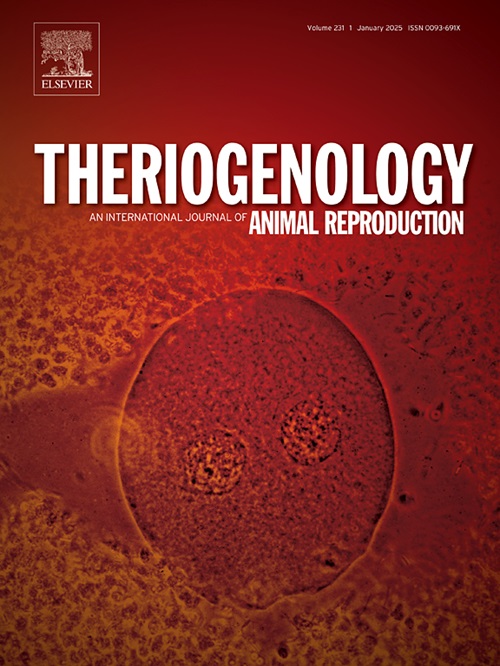Interference with the interaction between sperm arylsulfatase A and sulfated carbohydrate chain residues of the zona pellucida effectively suppresses polyspermy during in vitro fertilization of porcine oocytes
IF 2.4
2区 农林科学
Q3 REPRODUCTIVE BIOLOGY
引用次数: 0
Abstract
The present study investigated the effects of treatments with sulfatase to desulfate the sulfated carbohydrate chain residues of the zona pellucida (ZP) and arylsulfatase A-blocking peptide (ARSA-BP) for the specific masking of sperm ARSA on the interaction of sperm ARSA with ZP, which plays an important role in the in vitro fertilization (IVF) of porcine oocytes. The pretreatment of oocytes with sulfatase for 10 min before the onset of insemination or the addition of 5 ng/mL ARSA-BP to IVF medium significantly reduced the incidence of polyspermy; however, these treatments did not affect sperm penetrability or male pronucleus formation. Combined treatments with sulfatase plus ARSA-BP significantly reduced the incidence of polyspermy to the range of 23–26 % under conditions maintaining a high sperm penetration rate from that of untreated oocytes (56 %). Although the treatments with sulfatase or ARSA-BP alone and sulfatase plus ARSA-BP during IVF did not affect the number of sperm that bound to the ZP or ZP solubility, the incidence of sperm with the acrosome reaction that bound to the ZP was efficiently reduced by the treatment. In oocytes treated with ARSA-BP but not sulfatase, developmental potency to the blastocyst stage was enhanced by decreasing the number of apoptotic blastomeres. Therefore, the present results clearly indicate that interference with the interaction between sperm ARSA and sulfated ZP glycoprotein residues reduced the induction of the acrosome reaction in sperm that bound to the ZP, effectively suppressing polyspermy during porcine IVF.
干扰精子芳基硫酸酯酶A与透明带硫酸碳水化合物链残基之间的相互作用可有效抑制猪卵母细胞体外受精过程中的多精现象
本研究研究了磺化酶对透明带(ZP)和芳基磺化酶a阻断肽(ARSA- bp)硫代碳水化合物链残基的脱硫处理对精子ARSA与ZP相互作用的影响,该作用在猪卵母细胞体外受精(IVF)中起重要作用。在授精前用硫酸酯酶预处理卵母细胞10 min或在体外受精培养基中添加5 ng/mL ARSA-BP可显著降低多精的发生率;然而,这些处理不影响精子的穿透性或雄性原核的形成。磺化酶加ARSA-BP联合治疗显著降低了多精症的发生率,在保持未处理卵母细胞的高精子穿透率(56%)的条件下,多精症的发生率降至23 - 26%。虽然在体外受精过程中单独使用磺胺脂酶或ARSA-BP以及磺胺脂酶加ARSA-BP处理不影响与ZP结合的精子数量或ZP的溶解度,但处理有效地降低了与ZP结合的顶体反应的精子发生率。在ARSA-BP而非磺化酶处理的卵母细胞中,通过减少凋亡的卵裂球数量,卵泡期的发育能力得到增强。因此,本研究结果清楚地表明,干扰精子ARSA与硫酸化ZP糖蛋白残基之间的相互作用,减少了与ZP结合的精子顶体反应的诱导,有效地抑制了猪体外受精过程中的多精现象。
本文章由计算机程序翻译,如有差异,请以英文原文为准。
求助全文
约1分钟内获得全文
求助全文
来源期刊

Theriogenology
农林科学-生殖生物学
CiteScore
5.50
自引率
14.30%
发文量
387
审稿时长
72 days
期刊介绍:
Theriogenology provides an international forum for researchers, clinicians, and industry professionals in animal reproductive biology. This acclaimed journal publishes articles on a wide range of topics in reproductive and developmental biology, of domestic mammal, avian, and aquatic species as well as wild species which are the object of veterinary care in research or conservation programs.
 求助内容:
求助内容: 应助结果提醒方式:
应助结果提醒方式:


